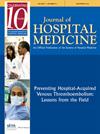Trends in resource utilization for new-onset psychosis hospitalizations at children's hospitals
Abstract
Background
Children with new-onset psychosis often require hospitalization for medical evaluation.
Objectives
The goal of this study was to assess variations in the management of children with new-onset psychosis and characterize trends in resource utilization.
Methods
The study included index hospitalizations for children ages 7–18 admitted to children's hospitals with a primary diagnosis of psychosis from 2011 to 2022 using the Pediatric Health Information System (PHIS) database. Children with a complex chronic condition were excluded. Resource utilization categories included medication, imaging, laboratory, and other clinical resources. Variability in resource utilization was assessed using covariance tests for random intercepts with generalized linear modes after adjusting for age, sex, payor, and severity. Trends in resource utilization were examined using generalized estimating equations adjusting for the same factors and accounting for hospital clustering.
Results
Our data set included 7126 new-onset psychosis hospitalizations from 37 children's hospitals. Teenage males and non-Hispanic Whites were most likely to be hospitalized. There was a significant variation in resource utilization across hospitals in all categories (p < .001). The most frequently utilized resources were antipsychotic medications (76%), serum chemistry (77%), toxicology labs (72%), and brain magnetic resonance imaging (22%). The most notable increases in utilization were in the performance of laboratory tests, brain imaging, anesthetic use, and intravenous immunoglobulin use.
Conclusion
Study findings suggest that there has been a stable rate of hospitalization for children with new-onset psychosis, yet a significant variation in the medical evaluation exists. Significant increases and variations in resource utilization across all categories suggest an emerging need for robust evidence and consensus-based practice guidelines.





 求助内容:
求助内容: 应助结果提醒方式:
应助结果提醒方式:


